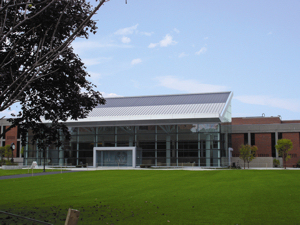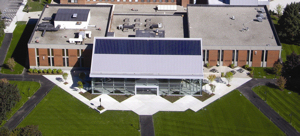Metals Roofs And Renewable Energy Systems – A Lasting Combination
 |
This standing-seam metal roof with thin-film building integrated photovoltaics generates electricity for the Slavin Center on the campus of Providence College in Providence, RI. It uses 4,880 square feet of 24-gauge steel panels and
72 18’ thin-film amorphous silicon laminates that are factory-applied. In this type of system, the amount of laminate depends on the energy needs of the building. The laminates in this system have a rating of 136 watts DC
each, yielding a total system rating of 9.792 kW. Photos courtesy of Roofing Concepts of East Greenwich, RI. |
 |
Slavin Center photos courtesy of Roofing Concepts of East Greenwich, RI. Click images to enlarge. |
By Scott Kriner, Technical Director, LEED AP, The Metal Initiative
A growing need to reduce energy consumption, waste, and CO2 emissions is clear. But the next step – how to reasonably achieve that – still needs to be addressed.
Building owners and developers face difficult challenges in this process, particularly when it comes to meeting stringent codes for energy efficiency in new and existing buildings. But a logical, easily accessible solution to this dilemma lies with
renewable energy systems integrated with metal roofs.
Value
Metal has several benefits for renewable energy systems. Durability is a major one, according to Tony DeLoach, owner of WES Industries, Sarasota FL, a company that engineers, designs and installs renewable energy systems.
“Metal roofing makes complete sense for solar because of the life of the metal roof at 40, 60 or more years. There’s nothing I know of that offers the kind of warranty as a standing seam metal roof. Plus, they’re now all very attractive
and come in a variety of colors. If our company owns the renewable energy system, we also look at the efficiency we can gain by mounting it on a metal roof. If we can incorporate the cost of the metal roof in the project we gain warranty and thermal
benefits and are still dollars ahead,” DeLoach says.
Metal roofing also allows the roof to be installed to a pitch that takes full advantage of the angle of the sun in a given location. This ability to customize the pitch maximizes a solar system’s output on a direct mount.
Costs
Building owners have several ways to fund a renewable energy system. The four main ways are to pay cash, obtain a bank loan, tap a line of credit or lease the system through vehicles such as a power purchase agreement (PPA). In a PPA, the developer
or other third party entity funds the renewable system and sells the energy to the building owner at a reduced rate.
According to Gregg Cassarini, Business Development Manager for Conergy, a solar energy company focused on large scale solar development projects, commercial projects generally average an 8 to 10 percent internal rate of return, but can be higher depending
on applicable incentive and cost structures.
“You need to look at all of the cost parameters, including installation and operating expenses, revenues, and borrowing costs to see how much you’ll get back over a certain time horizon. Some states have government subsidies for system
owners, which can be the host or a third party. Those incentives along with the electricity savings will provide the rate of return on the investment,” he said.
 |
| | The solar metal roofing panels featured on the Slavin Center were manufactured by ATAS International of Allentown, PA. To learn more about the company's products, visit www.atas.com. |
Conergy is based in Hamburg, Germany, and Cassarini is based in its U.S. headquarters in Denver. The company also is a wholesale distributor of solar products.
Other alternatives can trim the upfront cost of the system, according to Tom Price, Executive Director, of San Francisco-based Black Rock Solar. His organization is the nation’s largest non-profit installer of renewable energy. It obtains most
of its funding from public utility rebates and donations from foundations.
His company works with organizations that can’t afford the systems on their own and recently helped an elementary school in rural Nevada that was forced to lay off six of its 40 teachers due budget cuts.
“The school administrators thought they couldn’t afford a renewable energy system even though it’s what they needed to reduce costs. But we figured out how to have it paid almost entirely by rebates from utilities and raised the
balance through donations. After two months they saved enough money to hire back two teachers,” Price said.
“The exciting thing about renewable energy systems is that they’re not complicated they’re just unfamiliar to a lot of people. Any competent roofer can learn the basics in a day,” Price said.
Bright Future
The experts all agree that the use of renewable energy systems will continue to increase. And as long as the sun is in motion this market will grow and metal roofs will continue to be the choice for optimum long-term performance.
 The author, Scott Kriner, is the Technical Director, LEED AP, for The Metal Initiative. The Metal Initiative is an industry program that provides education and resources on the use of metal roof and wall components. The Metal Initiative programs offer educational presentations, Webinars, industry experts and technical resources.
The author, Scott Kriner, is the Technical Director, LEED AP, for The Metal Initiative. The Metal Initiative is an industry program that provides education and resources on the use of metal roof and wall components. The Metal Initiative programs offer educational presentations, Webinars, industry experts and technical resources.